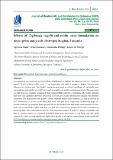| dc.description.abstract | An experiment was conducted at Jineri village, Singida rural to evaluate the effects of 10%(w/v) Tephrosia
vogelii (T) and 50%(v/v) rabbit urine (U) on insect pests and yield of cowpea in Singida Tanzania from
February 2021 to June 2021. The T and U treatments were mixed in 10% (v/v) sunflower oil, and sterile water
and synthetic pesticide (karate 2.5EC) were used as negative and positive control respectively. The experiment
was laid down in a complete randomized block design (CRBD) with three replications. The results indicated
that there was significant difference (P≤0.001) on insect pest counts between plots sprayed with different
treatments. The plots treated with positive control exhibited smaller mean number (4, 7 and 5) followed by
OUT formulation (11, 8 and 4) for aphid, leaf miner, and pod borer respectively, at flowering stage, i.e.,
seventh week after germination. Plots sprayed with sterile distilled water had higher mean numbers of insect
pests (25, 20 and 12) for aphid, leaf miner and pod borer respectively, compared with other treatments at
flowering stage. The resilts indicate that the OUT formulation improved yield to a degree comparable with
that of positive control, as evidenced from their close grain yield values of 794 kg/ha and 846 kg/ha
respectively, which are both significantly higher than 483 kg/ha of negative control. Based on the results, the
OUT-formulation is recommended for managing cowpea pests in the field. | en_US |

